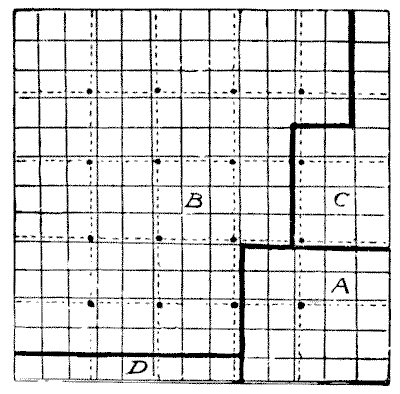
THE SQUARE OF VENEER.—solution

Any square number may be expressed as the sum of two squares in an infinite number of different ways. The solution of the present puzzle forms a simple demonstration of this rule. It is a condition that we give actual dimensions.
In this puzzle I ignore the known dimensions of our square and work on the assumption that it is 13n by 13n. The value of n we can afterwards determine. Divide the square as shown (where the dotted lines indicate the original markings) into 169 squares. As 169 is the sum of the two squares 144 and 25, we will proceed to divide the veneer into two squares, measuring respectively 12x12 and 5x5; and as we know that two squares may be formed from one square by dissection in four pieces, we seek a solution in this number. The dark lines in the diagram show where the cuts are to be made. The square 5x5 is cut out whole, and the larger square is formed from the remaining three pieces, B, C, and D, which the reader can easily fit together.
Now, n is clearly 5/13 of an inch. Consequently our larger square must be 60/13 in. × 60/13 in., and our smaller square 25/13 in. × 25/13 in. The square of 60/13 added to the square of 25/13 is 25. The square is thus divided into as few as four pieces that form two squares of known dimensions, and all the sixteen nails are avoided.
Here is a general formula for finding two squares whose sum shall equal a given square, say a². In the case of the solution of our puzzle p = 3, q = 2, and a = 5.
_________________________
2pqa \/ a²( p² + q²)² - (2pqa)²
--------- = x; --------------------------- = y
p² + q² p² + q²
Here x² + y² = a².
click here to go to my blog.
See more interesting puzzles at http://puzzles.50webs.org